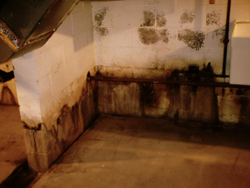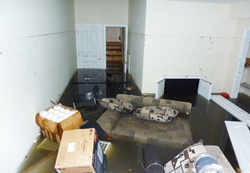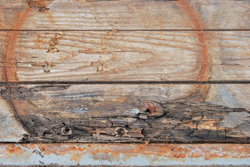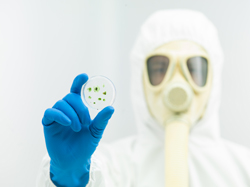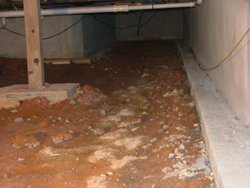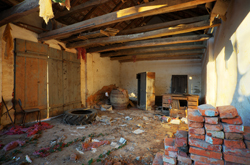Top Ten Mold Facts
Mold Fact 1: The Key Ingredient Mold Needs To Thrive Is Moisture
Mold has a purpose in our eco-system, ie. to consume dead organic material. It poses health hazards when it begins growing in indoor environments. Mold gets indoors through open doorways, windows, heating, ventilation and air conditioning systems. Spores in the air outside also attach themselves to clothing, animals, shoes, bags and more!
Commons sources of moisture include the following: flooding; backed-up sewers; leaky roofs and/or water leaks; humidifier which is not regularly cleaned and disinfected; damp basements or crawl spaces; house plants and their debris; steam from cooking and showers; wet clothes hung to dry indoors; inadequate air exchange; excessive humidity; and condensation, which is especially a problem during the winter, on poorly insulated surfaces.
To prevent mold growth, control moisture and maintain an interior humidity level of between 30 to 40%.
Mold Fact 2: Buildings and Homes Provide the Perfect Food For Mold
Since mold’s purpose is to break down and consume dead organic material, modern day buildings and homes provide an ample food source because they are constructed using materials that mold loves to feed on: wood & wood products; paper and other paper products like cardboard and wallpaper; leather; fabric and upholstery; grout; painted walls; cement; plaster (drywall); ceiling tiles; insulation materials; and carpet.
Mold Fact 3: Mold Needs Less Than 2 Days To Begin Growing
Mold requires three key ingredients to grow:
1. Food as documented in mold fact 2;
2. The ideal temperature of 5 degrees to 38 degrees; and
3. Moisture is the key ingredient.
In the presence of moisture, the ideal temperature, and ample food, mold will begin growing within 24 to 48 hours.
Mold Fact 4: There Are 3 Distinct Types of Mold
Of the 100,000 types of mold that have been identified, the three most common types of mold are:
1. Allergenic Molds are not usually life-threatening but are most problematic for individuals with allergies or asthma. The challenge is figuring out what mold is triggering the reaction. Children are particularly susceptible to mold allergies.
2. Pathogenic Molds produce an infection of particular concern if your immune system is weak or compromised. This type of mold can cause hypersensitivity pneumonitis, an acute response resembling bacterial pneumonia. An example is Aspergillus fumigatus, which can grow in the lungs of immune-compromised individuals.
3. Toxigenic Molds produce mycotoxins that will make anyone sick. Possible reactions include immune suppression and cancer. Mycotoxins are chemical toxins present within or on the surface of the mold spore, which can be inhaled, ingested, or touched. An example of this is aflatoxin, one of the most potent carcinogens known to mankind. Aflatoxin grows on peanuts and grains, and on some other foods.
Mold Fact 5: There Are 5 Distinct Species of Mold
The five most prevalent species of mold are:
1. Alternaria mold is commonly found in your nose, mouth and upper respiratory tract and can cause allergic responses.
2. Aspergillus mold is usually found in warm, extremely damp climates, and a common occupant of house dust. This mold produces mycotoxins which is a poisonous chemical compound. This mold variety can cause lung infections including aspergillosis.
3. Cladosporium mold is a very common outdoor fungus that can find its way indoors and grow on textiles, wood and other damp, porous materials. This mold triggers hay fever and asthma symptoms.
4. Penicillium mold is a very common species found on wallpaper, decaying fabrics, carpet, and fiberglass duct insulation. It is known for causing allergies and asthma. Some species produce mycotoxins, one being the common antibiotic penicillin.
5. Stachybotrys mold is extremely toxic “black mold” that produces mycotoxins that can cause serious breathing difficulties and bleeding of the lungs. This mold can be found on wood or paper.
Mold Fact 6: Most Mold Is Hidden
Many people don’t think they have mold because they can not see it. That is a problem because common hiding places for mold include the inside of drywall, behind improperly installed showers, in leaking roofs, and in crawl spaces with poor circulation.
Mold can be detected through smell, visual clues, and knowledge of the building history, ie. was there a flood or indoor leak.
Mold detection requires trained professionals because they have the tools and knowledge to know what to look for.
The first priority of the mold inspector / indoor air quality specialist is to determine if mold is an issue. They will determine this with an interview to learn more about the building history, take moisture readings to determine if there is a source of moisture required for mold growth, and conduct visual inspections.
Other recommendation of the inspector may also include thermal imaging if an identifiable moisture source is not present, but mold is detected. The inspector may also take samples of suspect mold with a a swab test, tape sample, or air quality test. These tests will determine the type of mold and spore count present. The goal of the mold inspection is to determine the extent of the mold problem so recommendations can be made to bring the fungal ecology to a healthy level.
If it is verified that mold is present, then the source of the moisture problem must first be fixed before removing the mold.
Mold Fact 7: The World Health Organization (WHO) Acknowledges That Mold Is A Health Hazard
In 2009, The WHO published, a 228 page document: WHO Guidelines for Indoor Air Quality: Dampness and Mould and concluded:
When sufficient moisture is available, hundreds of species of bacteria and fungi – particularly mould – pollute indoor air. The most important effects of exposure to these pollutants are the increased prevalence of respiratory symptoms, allergies, and asthma, as well as disturbance of the immune system. Preventing (or minimizing) persistent dampness and microbial growth on interior surfaces and building structures is the most important means of avoiding harmful effects on health.
Mold Fact 8: 1 in 4 People Have A Genetic Predisposition To Mold Illness
Dr. Richie Shoemaker, a physician and expert in the field of biotoxin-related illness and author of the book Surviving Mold, believes that 25% of the population has a genetic pre-disposition to the mold illness, Chronic Inflammatory Response Syndrome (CIRS), also known as Sick Building Syndrome (SBS):
Genes made them prime targets for an assault by their own innate immune systems….exposure to the interior environment of a Water-Damaged Building (WDB), [causes] an innate immune response that is going haywire.
Individuals exposed to the toxins in a water damaged building suffer from chronic illness because their bodies are trying to eliminate the foreign substances that stay in the body resulting in chronic inflammation and multiple symptoms. It is difficult to diagnose CIRS because there are 37 symptoms: fatigue; weakness; aches; muscle cramps; unusual pain; ice pick pain; headache; light sensitivity; red eyes; blurred vision; tearing; sinus problems; cough; shortness of breath; abdominal pain; diarrhea; joint pain; morning stiffness; memory issues; focus/concentration issues; word recollection issues; decreased learning of new knowledge; confusion; disorientation; skin sensitivity; mood swings; appetite swings; sweats (especially night sweats); temperature regulation or dysregulation problems; excessive thirst; increased urination; static shocks; numbness; tingling; vertigo; metallic taste; and tremors.
Because of the large number of symptoms and different combinations that a patient can have, CIRS is difficult to diagnose.
Mold Fact 9: Most Doctors Do Not Have Training To Identify Mold Illness
According to the producers of the MOLDY Documentary released earlier this year, most Physicians do not understand or have the knowledge to properly diagnose patients with mold sickness:
Possibly every doctor in the United States is treating mold illness, and they just don’t realize it. (Dr. Scott McMahon, MD)
Wonder Makers Environmental, a company based in Michigan, launched a website, www.moldsensitized.com to educate consumers, contractors, and health professionals on the health concerns caused by mold. Since launching the site, several mold sensitized individuals have been interviewed. Five key lessons are gained from these interviews:
- There is a lack of appreciation among medical professionals of health impact of mold.
- Mold sickness symptoms are broad, leading to multiple mis-dagnosis of patients by several different physicians.
- Mold sensitized individuals seek help from multiple medical practitioners and still do not get healthy.
- Over time, the patient discovers that mold is the cause of the sickness.
- Mold sensitized individuals are often forced to seek alternative shelters because traditional remediation approaches are not adequate.
Mold Fact 10: Failure To Fix A Mold Problem Will Reduce The Value Of Your Property
Mold is a serious issue. If you leave it untreated, it continues to grow. It leads to respiratory illness and it rots the wood, leaving the property valueless. (Ian Schlake of Respond and Rebuild)
In addition to the health concerns caused by mold, it is important to understand that mold is like a parasite or cancer and will continue to feed on your home until it is removed and the conditions causing the mold growth are fixed. Failure to fix the underlying causes of the mold and effectively removing the mold will lead to reduced property values caused by structural damage.
Questions about mold? Call us,(470) 545-4467, or send us an e-mail. We look forward to serving you!
One in four residents of Georgia are susceptible to mold illness. Get the facts!
Posted by Mold-B-Gone Remediation, LLC on Friday, August 7, 2015
Top 10 #Facts About #Mold http://t.co/U6q8MbCp1p PLEASE RETWEET pic.twitter.com/x2GEIKVQfQ
— Mold B Gone (@moldbgonega) August 8, 2015

